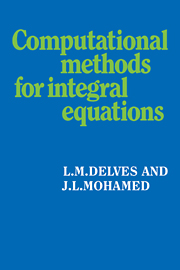Book contents
- Frontmatter
- Contents
- Preface
- 0 Introduction and preliminaries
- 1 The space ℒ2(a,b)
- 2 Numerical quadrature
- 3 Introduction to the theory of linear integral equations of the second kind
- 4 The Nystrom (quadrature) method for Fredholm equations of the second kind
- 5 Quadrature methods for Volterra equations of the second kind
- 6 Eigenvalue problems and the Fredholm alternative
- 7 Expansion methods for Fredholm equations of the second kind
- 8 Numerical techniques for expansion methods
- 9 Analysis of the Galerkin method with orthogonal basis
- 10 Numerical performance of algorithms for Fredholm equations of the second kind
- 11 Singular integral equations
- 12 Integral equations of the first kind
- 13 Integro-differential equations
- Appendix: Singular expansions
- References
- Index
11 - Singular integral equations
Published online by Cambridge University Press: 07 December 2009
- Frontmatter
- Contents
- Preface
- 0 Introduction and preliminaries
- 1 The space ℒ2(a,b)
- 2 Numerical quadrature
- 3 Introduction to the theory of linear integral equations of the second kind
- 4 The Nystrom (quadrature) method for Fredholm equations of the second kind
- 5 Quadrature methods for Volterra equations of the second kind
- 6 Eigenvalue problems and the Fredholm alternative
- 7 Expansion methods for Fredholm equations of the second kind
- 8 Numerical techniques for expansion methods
- 9 Analysis of the Galerkin method with orthogonal basis
- 10 Numerical performance of algorithms for Fredholm equations of the second kind
- 11 Singular integral equations
- 12 Integral equations of the first kind
- 13 Integro-differential equations
- Appendix: Singular expansions
- References
- Index
Summary
Introduction
So far we have been mainly concerned with methods for the solution of Fredholm and Volterra equations under the assumption that the kernel and driving terms are smooth functions of their arguments. When this assumption breaks down, the methods we have discussed will either fail completely (if they try to evaluate the kernel at a point where it is singular, for example) or at best converge only slowly. Singular integral equations are very common in practice, and we discuss in this chapter methods for dealing with them; the aim is, or should be, to produce not merely a method which converges, but one which takes sufficient account of the singularity that it converges as fast as methods for smooth problems.
This aim cannot always be met; when it can, it is clear that the resulting method must be tailored in some way to the form of the singularity. Fortunately a few standard types of singularity appear very common in integral equations. We shall use the term ‘singularity’ rather widely to refer to any lack of analyticity in the problem. Thus, for example, the following features make a problem singular:
(i) An infinite or semi-infinite range [a, b] for the integral operator,
(ii) A discontinuous derivative in the kernel or driving term. Hence, a Green's function kernel (see for example (0.3.16)) is singular in this sense.
(iii) An infinite or non-existing derivative of some finite order. Thus, y(s) = (1 − s2)½ is singular on the range [−, 1] because y′(s) is unbounded at s = α 1. It is nonsingular on the range [−±, ±].
- Type
- Chapter
- Information
- Computational Methods for Integral Equations , pp. 261 - 298Publisher: Cambridge University PressPrint publication year: 1985



